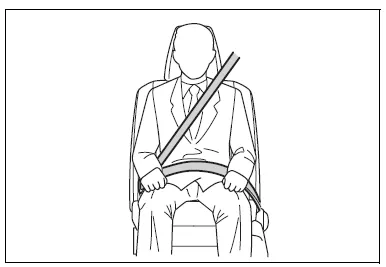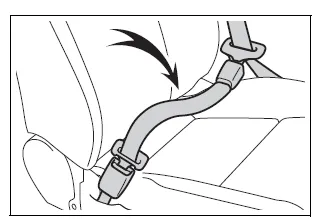Toyota Corolla (E210) 2019-2024 Owners Manual / For safety and security / For safe use / Correct use of the seat
belts
Toyota Corolla (E210): Correct use of the seat belts

- Extend the shoulder belt so that it comes fully over the shoulder, but does not come into contact with the neck or slide off the shoulder.
- Position the lap belt as low as possible over the hips.
- Adjust the position of the seatback. Sit up straight and well back in the seat.
- Do not twist the seat belt.
■Child seat belt usage
The seat belts of your vehicle were principally designed for persons of adult size.
- Use a child restraint system appropriate for the child, until the child becomes large enough to properly wear the vehicle's seat belt.
- When the child becomes large enough to properly wear the vehicle's seat belt, follow the instructions regarding seat belt usage.
■Seat belt extender
If your seat belts cannot be fastened securely because they are not long enough, a personalized seat belt extender is available from your Toyota dealer free of charge.

WARNING
■Using a seat belt extender
- Do not wear the seat belt extender if you can fasten the seat belt without the extender.
- Do not use the seat belt extender when installing a child restraint system because the belt will not securely hold the child restraint system, increasing the risk of death or serious injury in the event of an accident.
- The personalized extender may not be safe on another vehicle, when used by another person, or at a different seating position other than the one originally intended.
NOTICE
■When using a seat belt extender
When releasing the seat belt, press on the buckle release button on the extender, not on the seat belt.
This helps prevent damage to the vehicle interior and the extender itself.
Other materials:
Inspection procedure
1 Inspect cruise control actuator assy
Turn the ignition switch to off.
disconnect the cruise control actuator assy connector.
measure the resistance between terminals 1 (mo) and 2
(mc) of cruise control actuator assy.
Hint:
if control plate position is fully opened or ...
Circuit description
Refer to dtc p0130
Dtc no
Dtc detection condition
Trouble area
P0136
The following condition (a) or (b) continues for 300 seconds or
more:
During driving with the engine warmed up, heated oxygen
sensor o tp t does not change
output change.
he ...
Circuit description
The shift solenoid valve sl is turned ”on” and ”off” by signals from the ecm
in order to control the hydraulic
pressure operation, the lock–up relay valve, which then the controls operation
of the lock–up clutch.
Fail safe function:
if the ecm detects a malfunction, it turns the ...


